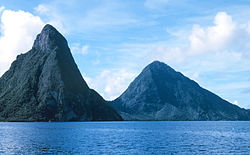Flag of Saint Lucia
The national flag of Saint Lucia was initially adopted on March 1, 1967 and definitively adopted on February 22, 1979 and slightly modified on February 22, 2002. It consists of a light blue background with two central isosceles triangles, the first black with white edges and a superimposed yellow triangle.
It was designed by local artist Dunstan St Omer.
Construction
The triangles overlap, black on white and gold on black. The black figure resembles an arrowhead in the center of the flag. The white part of the triangle forms a border to the black triangle which has a width of 1 and 1/2. The distance between the points of the black and white triangles is 4 inches. The triangles share a common base, whose ratio to the length of the flag is 1/3.
The dimensions of the triangles are 6'×3' and 9"×4½" in the imperial system.
Colors
As found on the web page titled "The Flag of Saint Lucia", the Government of this country establishes as official colors: blue is RGB 99, 207, 254. Yellow is of 255, 223, 0. Black and white are absolute, 0, 0, 0 and 255, 255, 255, respectively.
Symbolism
The color blue represents fidelity and loyalty, the tropical sky and the waters of the Caribbean Sea and the Atlantic Ocean. Gold represents prosperity, wealth, beaches and the Caribbean sun. Black and white represent the mixture of races that gave the island its identity, and where the largest area of black color indicates the great influence of this race in the idiosyncrasy of the country.
The isosceles triangles represent the Pitons Mountains (Twin Peaks Gros Piton and Petit Piton) which are part of the Qualibou (or Gimie) volcanic geological formation, and are They rise almost 800 meters above sea level, it is the emblem of the island, as a symbol of the hope and aspirations of the people of Santa Lucia. It is also an important tourist attraction and Natural Heritage declared by UNESCO.
History
During the colony the Blue Ensign flag was implemented with a shield on the right side, initially the shield in a circular shape was represented to the island and to the west the two peaks of the volcano and a ship arriving at the port, at the bottom was the motto "Haud STATIO MALEFIDA CARINIS" (Safe Harbor for Ships), this flag had a ratio of 1:2.
On August 19, 1939, the coat of arms of the country was replaced, which was black where two bamboos crossed, which was divided into four rooms, in the first and the fourth there were two red roses (symbol of England). and in the remaining, second and fourth two yellow lilies (symbol of France).
The basic design of the national flag dates from 1967, when Saint Lucia became an Associated State, it differs from the current one in that its proportion was 5:8 and the yellow triangle was smaller, in 1979 the current proportions; In addition, the blue tones have also initially varied, first a medium blue, then a dark blue and finally the current light blue tone.
Historical Flags
Contenido relacionado
Olmec culture
V millennium BC c.
Murphy's War





![[3] 1979-2002](https://upload.wikimedia.org/wikipedia/commons/thumb/e/ea/Flag_of_Saint_Lucia_%281979%E2%80%932002%29.svg/120px-Flag_of_Saint_Lucia_%281979%E2%80%932002%29.svg.png)
